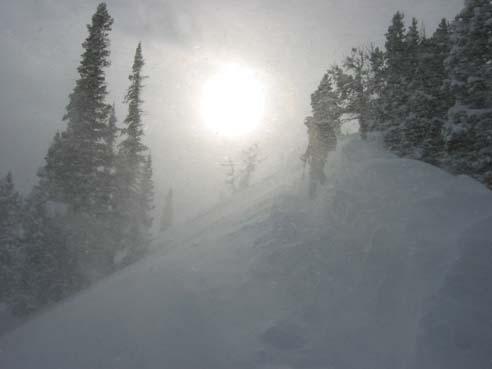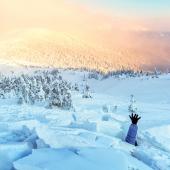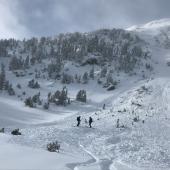Avalanche!
As you hike slowly up through the deep snow, the cold air stinging your face, you hear a CRRRAAACK so loud and deep it echoes down the canyon and shakes the new snow off the trees. You turn to move, but, before you can, you’re tumbling. Down and down the slope in a tidal wave of ice and snow chunks. You’re thrown about like a shoe in the dryer. If you don’t smash into rocks and trees you may be crushed by the ice chunks falling with you. When you stop, if you’re still alive, you’ll likely suffocate with the tons of concretelike snow compacted all around you. But if your friends are prepared and trained, you could be found and dug out in less than two minutes. And knowing what forces and circumstances combine to create these deadly winter occurrences can help you make decisions to avoid danger areas altogether.
Countless factors go into making an avalanche, but the most deadly—slab avalanches—have two basic characteristics: an accumulation of snow and a weak layer somewhere in that snow.
Anatomy of a Snowpack
It begins with the gathering of clouds. High cirrus clouds, say. Innocent-looking enough, these high-altitude, wispy clouds often run with the jet stream and bring in the bitter cold and snow. In these clouds, sometimes as high as 50,000 feet, ice particles make up most of the matter. They begin to attach themselves to each other, dust, and water vapor, gaining size and weight until, finally, they give way to gravity. If conditions are right and temperatures are around 10 degrees farenheit, they make it to the ground as big, fat, beautiful snowflakes—the kind that make every Bozemanite start cooking up work excuses and looking for the shovel and transceiver. But also the kind that can build up to make a snowpack into a ticking time bomb for an unsuspecting skier. The kind that could add weight to a weak lower layer and when set off, shear into huge chunks of hardened snow and ice—a slab avalanche.
Dependent on more factors than could be discussed in one article, the dynamics of a snowpack take shape early in the season with the first snowfall. From there, the amount of wind-loaded snow, temperature, slope of the hill, aspect (which direction the hillside faces), leeward or windward orientation, humidity, and how the lower layers were formed all contribute to the character of a snowpack. But what makes a snowpack into a deadly slab avalanche? First, it begins with the creation of a weak layer, something that gives way to the weight of the layers above. How this weak layer forms can be quite complex, but there are three general ways.
Formation of Depth Hoar
When the flakes are falling, they are usually fine grained, but as the flakes land, they almost immediately undergo transformation. Imagine you're a snowflake near the ground, say up in the Gallatin Range. The ground, retaining heat, warms you up and just like being in a fluffy down jacket, you start to pump water vapor into the air spaces between your fluffy crystals. This vapor moves upward, to colder snowflakes in the snowpack, and recrystallizes. Neither the density nor the thickness of the snowpack changes, but a weak, unstable, and invisible layer forms nonetheless. This weak bottom layer is called depth hoar. The rate of recrystallization depends on the temperature gradient. Depth hoar forms faster in shallow snow and cold weather.
Near-Surface Faceting
Just under the top of a snowpack, a similar phenomenon can occur. Near-surface faceting describes the formation of a weak layer near the surface of the snowpack and was first theorized by Bozeman resident and National Avalnache Center snow scientist Karl Birkeland. In near-surface faceting, weak crystals similar to depth hoar are produced when water vapor forms and recrystallizes under a high temperature gradient. But here, a quick temperature change must take place deep within the snow. And, according to Birkeland’s reports, a significant layer of faceted (weak) snow forms within a day and a half. These faceted crystals have poor bonding properties, making the layer prone to breaking away and sliding with the accumulation of more snow. Simply stated, a dramatic change in temperature can be quite dangerous, especially if more snow follows in the next week or two.
Formation of Surface Hoar
A third type of weakness occurs at the snow surface. When you waddle out to the car on a winter morning and end up having to scrape a frosty windshield, you experience how water vapor in the atmosphere likes to crystallize on the coldest thing around. Similarly, a layer of snow gets cold after spending all night losing infrared radiation to the sky. By morning, a layer of large ice crystals may be deposited on the snow, forming surface hoar that future snowfalls can't bond strongly to. With enough new snow, the situation can resemble that of a concrete slab perched atop a layer of ball bearings.
So, you’ve got a weak layer and then an accumulation of snow, what else do you need to make an avalanche? Well, you need a trigger, something to set it off—and hopefully that’s not you.
What Can You Do?
Backcountry travelers have tons of resources available for educating and helping protect themselves from becoming victims of an avalanche. The first step is learning to recognize the signs of an avalanche.
Look for avalanche tracks. Look around to see where previous avalanches have cut a path through the trees. This is a huge clue that there may be an avalanche in that spot again. It may look great for skiing, but there is a reason that no trees have grown there. Also, look for trees that only have branches growing on the downhill side.
Stay off slopes between 30 and 45 degrees. On significantly steeper slopes, the snow generally sloughs off before it can build into an avalanche. On shallower slopes, the snow has little reason to move—although avalanches often extend beyond the slope onto flatter run-out zones.
Identify recent avalanches in the area. Seems obvious, but there is more to this than just avoiding where the avalanche occurred. Look for clues, like the characteristics of the hill. What direction is it facing? How steep? Is it wind-loaded? Try to avoid slopes that match those characteristics. Sometimes all the snow in a particular area is unstable.
Listen for a “whoomping” sound from the snow. Indicates a small or large failure. You will hear this often if you travel in the backcountry much. Take notice—it’s a sign of an unstable snowpack.
Practice. Have a friend bury a backpack with your transceiver in it and then try to find it as fast as possible. Switch and let her try. It is best to do this again at the beginning of every trip. Also, go over safety procedures for skiing down the slope—e.g., one at a time.
Take advantage of local resources. The Gallatin National Forest Avalanche Center (GNFAC) is probably the single greatest resource for anyone who travels in the outdoors in the winter around here. Backcountry travelers can call or log in to the Avalanche Center to report conditions they experienced, and staffers there spend a good portion of the week in the backcountry testing conditions themselves. The GNFAC’s annual classes offer a chance to get cheap ($25), professional, hands-on instruction and should absolutely be an annual requirement by anyone using the backcountry.
There is a balance somewhere between risk and safety, between courage and foolishness, and I think most of us cross back and forth over it. To some, just successfully negotiating traffic on the way to work is reason enough to plant a well-deserved coffee cup on the desk like a flag bearing witness to your travails. For others, hanging on a thin ribbon of ice by a nylon leash far above frozen ground is completely within the realm of comfort. So, we each must learn the signs of danger, stay alert to conditions, and then make decisions according to our own comfort and risk level as well as that of our partners.
Kent Orms was once caught in a small but scary avalanche, and since then he's significantly improved his avalanche safety skills. Kent has been Outside Bozeman's contributing editor for the last two years.












